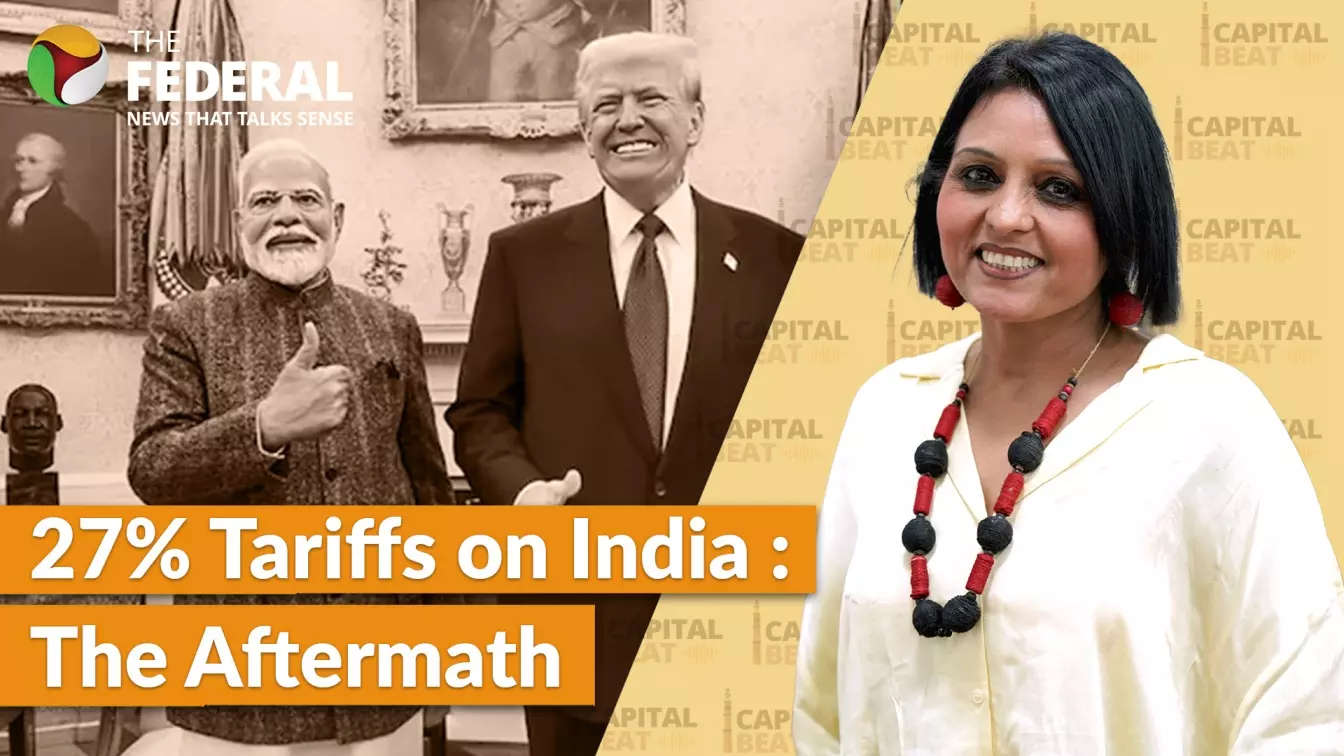
US tariffs on India
Donald Trump's 27% tariff on India: Impact on Indian economy
Trump slaps 27% tariff on India, citing unfair trade. Can India’s economy absorb the shock?

In this episode of Capital Beat, The Federal’s Neelu Vyas sat down with renowned economist Prof Santosh Mehrotra to decode the implications of US President Donald Trump’s newly announced 27% reciprocal tariff on India. As tensions rise globally over this unexpected economic manoeuvre, Mehrotra weighs in on what it really means for Indian industry, exports, and diplomacy.
Tariff shock: What just happened?
On April 2, 2025, Donald Trump made headlines with what he called the “Liberation Day” announcement in the Rose Garden of the White House. Declaring the rebirth of American industry, Trump imposed tariffs of 27% on Indian goods, 34% on China, 20% on the EU, and 24% on Japan.
Also read: India faces selective trade headwinds from US tariff impact, apparel sector most hit
Calling PM Narendra Modi a “great friend,” Trump nonetheless complained that India was “not treating us right.” He justified the tariff by claiming India charges the US a 52% import duty—hence the reciprocal 27%.
What it means for the US
Mehrotra was blunt: “It will manifest into higher prices for the American consumer.” He noted that US inflation is already soaring and further tariffs could worsen the crisis. “This is not economics; it’s politics,” he said, describing Trump’s policy as short-sighted.
Mehrotra explained that the move won’t create manufacturing jobs in the US overnight. “This idea that jobs will suddenly pop up is utter rubbish,” he stated, adding that any long-term gains are questionable.
India’s exposure and exemptions
Contrary to alarmist claims, Mehrotra clarified that Indian exports to the US make up only 3–4% of India’s GDP. “The US is our biggest trade partner, yes—but in GDP terms, it’s a small slice,” he said.
More importantly, some major Indian export sectors were exempt. These include:
Pharmaceuticals
Semiconductors
Auto components
Competitive edge in key sectors
India may have gained a relative advantage in certain sectors. For instance, while Indian smartphones will now attract a 27% tariff, Chinese phones will be taxed at 54% and Vietnam’s at 46%. “There’s no room for complacency,” Mehrotra warned, “but the playing field isn’t entirely levelled against us either.”
Vietnam and China remain stiff competition, but Brazil—with just a 10% tariff and proximity to the US—could emerge as a new threat.
Could the tariffs be reversed?
There is some hope. Mehrotra revealed that India and the US are already engaged in negotiations for a bilateral trade agreement (BTA), with a soft deadline set for September 2025. “Everything we’re seeing could be part of a larger deal-making process,” he said.
If political backlash in the US intensifies due to rising prices and no visible job creation, Trump may be forced to walk back some of his tariff decisions.
Not as bad as it seems
Mehrotra argued that fears about India’s economy being devastated are overblown. “This won’t wipe out our industry,” he said, countering doom-and-gloom predictions.
Also read: Trump’s tariffs: These Indian sectors may be worst hit but experts spot ‘gains’ too
Even in sectors like apparel—where India exports nearly $4–5 billion annually—Vietnam is facing stiffer tariffs. Likewise, in agriculture, India’s seafood and rice exports remain competitively placed, with rivals facing higher levies.
Stay cautious, not fearful
While India needs to respond strategically, the situation isn’t catastrophic. “Let us be grateful for small mercies,” Mehrotra concluded. “Yes, some product areas will be hit, but the broader picture is far from gloomy.”
He emphasised the need for India to continue improving productivity and competitiveness, particularly since the tariff may evolve through diplomatic negotiations in the coming months.
The content above has been generated using a fine-tuned AI model. To ensure accuracy, quality, and editorial integrity, we employ a Human-In-The-Loop (HITL) process. While AI assists in creating the initial draft, our experienced editorial team carefully reviews, edits, and refines the content before publication. At The Federal, we combine the efficiency of AI with the expertise of human editors to deliver reliable and insightful journalism.

